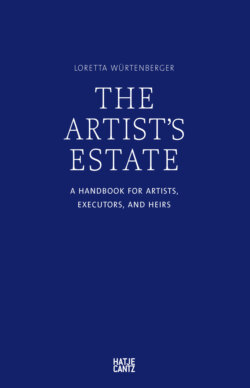Читать книгу The Artist's Estate - Группа авторов - Страница 17
На сайте Литреса книга снята с продажи.
2. Securing the Oeuvre
ОглавлениеParallel to developing a strategy, the estate of an artist should be secured after their death. If one of the tasks of art is bringing chaos into order, this dictum does not apply to artistis’ estates. Order in an estate is the most important prerequisite for a realistic assessment of the holdings as a basis for strategic and financing options.
The artworks in the estate come first. At the time of death, they are often “scattered” in various places: in the studio, in the home, in various storage spaces, with friends, on loan to museums, or with gallerists. Although it requires effort, initially bringing all the works together is recommended so that one can get one’s own impression of the condition and quality of the works. The case of an estate is like that of all art: nothing is a substitute for a direct, physical impression of the work. Doing this enables one to arrive at a realistic assessment and to truly become familiar with the oeuvre.
The work of sorting through the oeuvre should go hand in hand with cataloguing the artworks. When doing so, the following information should ideally be checked and / or compiled:15
1. Title, description, year of creation
2. Material and dimensions, including the size of the frame, other mounting or necessary architectural exhibition elements such as the base used, et cetera; weight in the case of sculptures
3. Inventory number and photo documentation of the work as well as signature and / or casting stamp found on the work
4. Essential requirements for conserving, storing, and exhibiting the artwork
5. Information about the process of creating the artwork and what materials were used—this can be beneficial for the long-term preservation of particular artworks
6. Current owner and location of the artwork
7. Current condition of the work
8. Invoices for the artwork
9. Correspondence about the artwork, including commissions, sales, donations, or loans
10. Exhibition catalogues or catalogue data for exhibitions of the artwork and / or exhibition history
11. Assessments and insurance documents
12. Selling prices achieved at auctions or private sales (as far as possible)
13. Information about the artwork provided by the artist, also within the context of other works or the oeuvre as a whole
14. Press articles and press photos with the artwork as their subject
15. Information about copyright, granting of use up to this point, and about license fees received
Ideally, the estate is able to refer to an inventory and organizational system that was set up during the artist’s lifetime. The professionalization of the contemporary art market will simplify the estate work of the future. If an artist today achieves enough success to work with a professional gallery, the processes connected with this success alone already make it necessary for artists to have professional studio management. If this is not the case, galleries often step in with appropriate support, ensuring that a copy of the material collected in the gallery is always made available to the artist for archival purposes.
Professional studio management consists of clean accounting along with the necessary archiving of production and sales documents, including details on buyers—which will be of importance for provenance information in later indexes of works—as well as ongoing cataloguing of the artworks. If a studio has reached a certain size, then assistants and a studio manager are also necessary.
Whether during an artist’s lifetime or first within the framework of estate work, there are various specialized software programs available for cataloguing works; these data sets can then be used as the basis for a catalogue raisonné. It is advisable to keep up-to-date with the current technical state of the art, since hard- and software continue to develop further, but here are a few examples of useful technology: the Vandenberghe siblings use the services of the Lightmachine Agency,16 the estate of Hans Arp uses a software solution from Hamburg-based Trenz AG,17 and the Zentrum Paul Klee uses the collection administration software MuseumPlus, conceived for museums by Zetcom AG,18 which also offers alternatives for private individuals with ArtPlus. There is a wide range of other suppliers such as Artsystems, Artworkarchive, and Collectionspace.19 When choosing a program, care should be taken that the software is able to depict catalogue raisonnés and other needs of an estate, and is not only oriented toward museum or gallery operations. Software tailored to museums or galleries often has functions that an estate does not require, while other functions that might also be quite useful at a later point are missing. The labeling of artworks should include not only the number assigned to the work, but also lasting coding such as a barcode or QR code (2D barcode) so as to make handling them more efficient. In ideal cases, the labeling can simultaneously be combined with the newest authentication technologies such as so-called bioengineered DNA technology. This involves giving artworks an artificial DNA to assist in recognizing the original artwork.20 It is a process developed by the nonprofit Global Center of Innovation for protecting against counterfeit art and is in turn supposed to become part of an entirely new global standard for marking and identification called i2M.21 A company providing modern solutions in this area is Tagsmart, a British company founded by artists, among others.22 As security, digital images of the works and the master data should be stored in an online storage device or cloud service (if the inventory program is not already online-based). The same applies for the whole archive after digitization.
